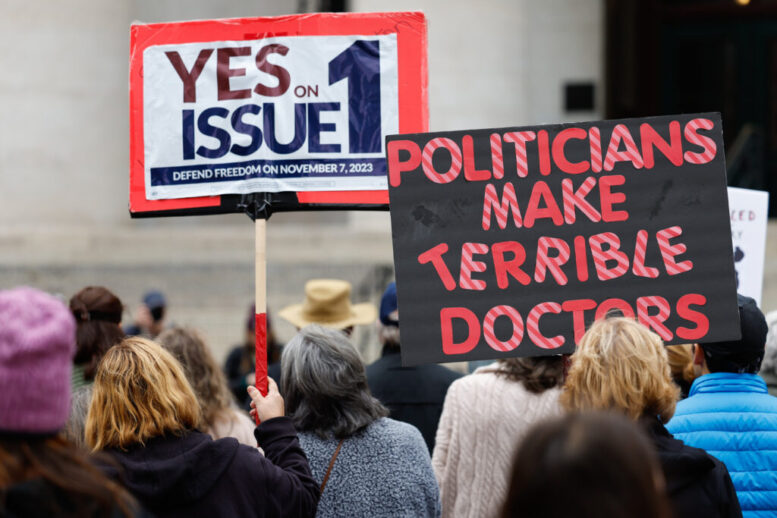BY SUSAN TEBBEN
Ohio voters passed the Issue 1 constitutional amendment to protect abortion and reproductive rights Tuesday. The Associated Press called the election over Issue 1 shortly after 9 p.m.
The amendment, brought by Ohio Physicians for Reproductive Rights, Ohioans for Reproductive Freedom and other reproductive rights advocacy groups, will enshrine abortion, contraception, fertility treatment, miscarriage care, and continuing one’s own pregnancy into the Ohio Constitution.
Nancy Kramer, co-chair of Ohioans United for Reproductive Rights and one of the individuals who led the constitutional amendment effort, said the amendment was a “citizen-led” effort full of “diverse and dynamic” people.
“We have marshaled the resources, the enthusiasm and now the votes of millions of Ohioans,” Kramer said at a Tuesday night watch party for Issue 1 supporters and the media.
The Issue 1 effort sought to stem attempts by both state and federal officials to regulate abortion through the use of bans and/or limits, and continue a burgeoning trend in the country that saw usual Republican strongholds like Kentucky and Kansas pass abortion rights measures by overwhelming numbers, along with Michigan, California and Vermont. Montana voters rejected an initiative that would have allowed criminal charges for providers who failed to take “reasonable actions” to save a fetus, even after an abortion.
In Ohio, a six-week ban with no exceptions for rape or incest was passed in 2019 and signed by Gov. Mike DeWine. Then it was tied up in court until the U.S. Supreme Court’s decision in Dobbs v. Jackson Women’s Health Organization overturned the national legalization of abortion in Roe v. Wade. That day, Ohio Attorney General Dave Yost moved to get the six-week ban released from its court entanglement, which allowed the ban to be implemented for 82 days in 2022.
Abortion rights groups tried to get the Ohio Supreme Court to intervene, but after weeks of inaction, the groups moved the case to the Hamilton County Court of Common Pleas, where a judge issued a preliminary injunction in the fall of 2022, pausing the ban indefinitely.
The case still has not been resolved, even causing the state to appeal the injunction to the Ohio Supreme Court. The state’s highest court heard arguments about the injunction, but still has not ruled on the appeal. The amendment’s passage will likely provoke further legal action and requests for judgment, though advocates have not yet declared what their next steps will be.
On the amendment’s passage, the organizing director for the ACLU of Ohio, Elizabeth Chasteen Day, said the conservative moniker has been assigned to Ohio, but that didn’t deter voters for Issue 1.
“They like to say we’re conservative, they like to count us out, but what we know about Ohioans is that you can’t count us out,” Chasteen Day said.
Hundreds of organizers, campaigners and canvassers attended the election night watch party for Issue 1, gathering to see the election results on TV monitors and join with fellow supporters.
Melinda Dobson attended Tuesday’s election night watch party for the Issue 1 supporters. Her husband works for the ACLU, but she took time to canvass today in Cincinnati before coming up for the event.
She said the issue comes down to the next generation, who she wants to set up for the future.
“I have a daughter and I really want to make sure that she has more rights than we do, not less rights,” Dobson said.
The road to Election Day
The summer started off with high hopes for the amendment after signature collectors submitted more than 400 boxes of signatures to the Ohio Secretary of State. Nearly 500,000 of the signatures were verified, indicating a large base of support for the amendment before campaigning had even begun.
The Ohio Ballot Board approved the language of the amendment, but changed the summary language that voters would see on their ballots, to the chagrin of abortion rights advocates, who said changing words like the medically-accepted “fetus” to “unborn child,” among other changes, slanted the summary in a way that misrepresented the amendment itself.
The Ohio Supreme Court disagreed for the most part after hearing a challenge to the changes. The court ruled that most of the changes could stay, with the exception of wording that assigned authority to the “citizens of the state of Ohio,” which the state supreme court ordered the ballot board to return to the previous language of “the state of Ohio.”
The amendment avoided another potential hurdle after state Republicans, including Ohio’s Secretary of State Frank LaRose, put their support behind a previous Issue 1 this August, which would have changed the Ohio Constitution by raising the threshold to pass any amendment from 50% to 60%. Ohio voters rejected that amendment with 57% against.
Polling since the amendment was introduced showed majority support for the measure, matching or exceeding public opinion polls from previous years.
Early voting showed the same support for the measure as polls seemed to, with Democratic areas of the state overperforming not only in favor of the abortion amendment, but also for Issue 2, the initiated statute to legalize marijuana.





